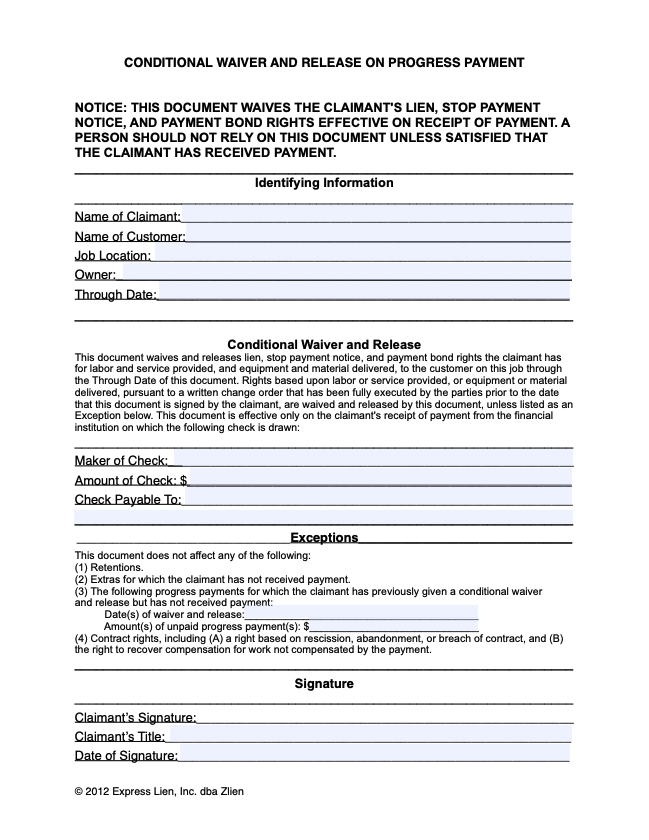
While some states don’t regulate lien waivers at all, California’s lien waiver rules are very specific, even providing the exact language required on each type of waiver form. When submitting a request for a progress payment, you will likely be asked to sign a Conditional Waiver and Release on Progress Payment. Because the state requires a standard form, it is quite simple to understand and use. In this article, we’ll show you exactly how to fill it out — and how to make sure that you’re submitting the right document.
Want to fill out and exchange your lien waiver as quickly and painlessly as possible? Send one through Levelset’s easy-to-use platform.
Prefer to do it yourself? Download the California Conditional Waiver & Release on Progress Payment form, and keep reading. We’ll walk you through each part of the form.
Choosing between California’s Waiver and Release forms
There are four different types of lien waivers in California, and each is used at different stages of a project. Fortunately, the intended use is pretty clear if you read the title of the form closely.
Conditional
A conditional waiver gives up lien rights, but only if one condition is met: You must receive the payment for the waiver to be effective. Once that payment hits your bank account, the waiver is just as enforceable as an unconditional waiver.
This form should be used while you are still waiting to be paid. If you have already received payment, you are likely safe to sign the unconditional version.
Waiver and Release
A lien waiver gives up the right to file a lien for the amount listed in the document. This protects the property owner from having a lien filed on the property, and (Technically, a lien waiver is different from a lien release, but California uses both terms to describe each of the four documents.)
Progress Payment
This waiver is for use with progress payments. A progress payment is an installment payment to the contractor, or in other words, a small partial payment on a larger contract that is proportional to the work done by the contractor actually performed during the payment period.
If submitting a pay application for the final payment on a project, you should use a different waiver form.
How to complete the Conditional Waiver and Release on Progress Payment form
Every waiver used upon a progress payment in California should have the exact same wording. It is literally spelled out in the state’s mechanics lien laws, so there’s no guesswork. We’ll look at each field in the form and what it is asking for.

Get the form
Download the Conditional Waiver and Release on Progress Payment form, prepared by construction attorneys to meet the statutory requirements.
1. Name of Claimant
The claimant is the party receiving the payment — in other words, the one waiving their lien rights. That would be you. Remember to identify your company name accurately. This sounds simple, but it’s common for companies to identify themselves incorrectly. For example, leaving out designations like Inc. or LLC, or to refer to DBAs incorrectly.
2. Name of Customer
The customer is the party who hired you, and typically the same party who is actually making the payment.
It’s possible that the party making the payment is not the customer. For example, if the GC hired you, but the property owner is paying you directly. In this instance, the “name of the customer” would be the general contractor. This scenario is typical when the parties are paying with joint checks.
3. Job Location
Do the best job you can identifying the job location. This is the physical place where you performed the work or where the materials were incorporated into the project (not where the materials were shipped).
A physical address will do just fine here. There are a lot of very strict requirements when identifying the job location in a mechanics lien claim, but the requirements for identifying the job location in a waiver are much more relaxed.
4. Owner
This field should identify the property owner(s). Again, while this is pretty straightforward, nuances about ownership could cause confusion. Here are some suggestions in common complex ownership scenarios:
- Multiple Owners: List all of the owners
- Work done for a tenant: List the tenant AND the property owner(s)
- Work managed by a construction manager: List the owners, not the mangers
- On Public Projects: List the government office that commissioned the work
- P3 Projects: Identify developers
5. Through Date
The “through date” field is very specific to waivers upon progress payment, and is very important. The through date is the most consequential field you’ll complete, because the through date determines what is waived and what is not waived by the document.
When you sign this lien waiver document, you are agreeing to waive your claims for all work completed on or before the date entered into this field.
Accordingly, the “progress payment” should completely compensate the waiving party for all work before on or before the date entered. Be careful that you identify the correct date (related to the work performed and paid for), and not just the date of the related payment application (which is irrelevant).

Need a lien waiver?
Create lien waivers in minutes for free. Send a signed waiver to your customer, or request a signature from vendors.
6. Maker of the Check
The “Maker of the Check” field is straightforward if the payment is by check, but can be a little confusing if it’s an electronic payment. Here, you’ll just want to use common sense. In every case, there is a “paying party,” and that is the party to identify here.
7. Amount of the Check
The amount of the check is the dollar amount of the payment (whether or not it is a physical check). If payment is by ACH, credit card, or something other than a check, use common sense, and just enter the amount of the payment in this field.
8. Check Payable To
This field can be a little more confusing than the “maker of the check” and “amount of the check” fields, especially for payments made electronically or through some other payment method (i.e. cash!).
Ultimately, the “Check Payable To” field is you, the party receiving payment. It’s possible that more than one party can receive the same payment. If it’s a joint check, you’ll want to include all parties to the check.
9. Exceptions
The Progress Payment lien waivers in California have certain things exempted from the waiver by default, which is great for the parties signing the waiver, as they don’t have to argue about these things.
Retention/retainage is excepted by default, as are “extras for which the claimant has not yet been paid,” and “contract rights.” If you have anything else that should not be waived, include it in the exceptions area.
Further, since this is a progress payment waiver, the exceptions area specifically requires you fill out the following, as applicable:
- Date(s) of Waiver and Release: This field should list the dates of any waivers previously signed for on this project, if payment has not been already received on those waivers. If nothing applies here, you can write-in N/A, or leave it empty.
- Amount(s) of Unpaid Progress Payment(s): In this field, you’ll list the amount(s) of the earlier unpaid progress payment(s), if any.
10. Claimant’s Signature
This is the signature of the individual signing the document on behalf of the claimant, and should be someone who has authority to make financial decisions for the company.
11. Claimant’s Title
The “Claimant’s Title” should list the job title or role of the individual signing the document.
12. Date of Signature
This is simply the calendar date that the document is signed.
California makes it easy to get lien waivers right
That’s it! Your Waiver and Release on Progress Payment should be complete.
Lien waivers are often overlooked but carry significant legal consequences. Hopefully this guide has clarified the form and its requirements.
Remember, if you are unsure which of the 4 possible California lien waiver forms you should use, then you should use this one, the Conditional Waiver and Release on Progress Payment form. It is the safest choice of the four.
Guides to California’s other waivers
For more guidance with California lien waivers, check out Levelset’s guides to the other lien waiver forms in California:
![Guide To California's Conditional Lien Waiver -- Progress Payment [Free Download]](https://www.levelset.com/wp-content/uploads/2019/04/California-Conditional-Lien-Waiver-Progress-Payment.jpg)

